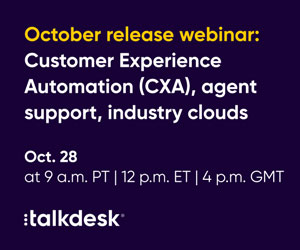Sunny Dhami of RingCentral introduces us to business intelligence (BI) and how it can work within your organization to improve efficiency and customer experience (CX).
Every year, the rising volume of data in the current marketplace pushes companies to think more carefully about how they can better understand and serve their customers.
Businesses of all sizes are quickly learning that only with the right insights can they make the decisions required to outshine the competition.
However, as the state of BI continues to evolve, driven by disruptive technology and new demands, there are still companies that don’t fully understand it.
Many organizations overlook BI solutions as something that’s “nice to have” when the truth is that they’re becoming absolutely essential to the modern landscape.
Here’s your guide to the reality of business intelligence, and why it matters in 2020 and beyond.
What Is Business Intelligence?
Business intelligence is a wide and comprehensive term used to refer to the tools, infrastructure, and processes that companies access to identify and analyse critical information.
Companies are accessing business intelligence software to help them extract valuable insights from an ever-growing quantity of data in their systems and operations.
Business intelligence technologies can be used with both external and internal data sources. In an external environment, they’re used for the collection of information on things like market trends and competitive intelligence.
In the internal environment, BI offers an overview of customer and industry pain points, key stakeholder requirements and lost opportunities.
Over the course of recent years, the business intelligence services in the landscape have evolved. BI doesn’t just belong to IT any more. Instead, it has emerged as a crucial business function.
Companies can access data insights that translate into useful information for individuals all across the company.
Choosing a Definition of Business Intelligence
As the BI landscape continues to evolve, more distinct definitions have begun to appear. It’s quickly becoming evident that there isn’t just one way to describe BI systems any more.
For instance, Wikipedia refers to business intelligence as a set of theories, processes, methodologies and technologies that can translate raw data into meaningful insights.
On the other hand, Hans Peter Luhn, the man regularly called the “father of business intelligence“, believes that BI is all about apprehending the interrelationships that are presented in facts in a way that drives progress towards a specific goal.
In 1989, Howard Dresner, the Gartner Group analyst, built on this idea by saying that business intelligence systems were concepts and methods created to improve business decisions using fact-based systems of support. Forrester then went on to say that business intelligence allows for the creation of more strategic, tactical, and effective operational insights and decision making.
The History of Business Intelligence
Perhaps to get a full answer to the question “What does business intelligence mean?” we need to look backwards into the history and evolution of the term.
The first mention of the term “business intelligence” came from an 1865 book named “Cyclopaedia of Commercial and Business Anecdotes” by Richard Miller Devens. The term is used to describe the use of knowledge and insights to achieve specific goals.
Technology didn’t become a component of the business intelligence system meaning until much later, in the 20th century. In 1958, Hans Peter Luhn published a landmark article on the subject of business intelligence. His article outlined business intelligence solutions as “automatic” systems that have been designed to analyse and disseminate information. Luhn believed that business intelligence solutions could be used to guide people towards specific goals using information and facts as evidence.
Luhn’s research established the original methods that were used to create some of the very first IBM analytical systems in the BI market. Since then, business intelligence software and technologies have continued to grow at an incredible pace.
Tool specification, the expansion of self-service options, and improved visualization have all changed the way that companies approach BI as a crucial analytical offering.
Crucially, the explosion of the big data revolution and the rise of the internet helped to promote business intelligence technologies like nothing else.
Today, organizations have more information than they’ve ever had before. Each individual is creating an increasingly large amount of information, with more than 204 emails sent every minute.
Today, we’re creating too much data to reasonably assess and organize on our own. We need business intelligence systems to ensure that we can transform the information that we collect into something consumable, usable, and valuable.
What Are the Features of Business Intelligence Services?
Business intelligence systems come in many different shapes and sizes. As companies have embraced different definitions of business intelligence technologies, we’ve seen the rise of different styles of software for the current landscape.
However, there are some common features that tend to remain the same throughout the BI environment.
Typical business intelligence software comes with access to various modes of advanced data analytics, including predictive analytics, data mining, statistical analysis, text mining, and more.
In many circumstances, advanced analytics projects are managed and conducted by teams of data scientists and statisticians, while the BI teams oversee things like the analysis and querying of business data.
Business intelligence tools collect data that can be sent to a data warehouse or housed in specific systems for analytics. Before data can be used in a BI application, raw information from a host of individual source systems needs to be cleansed and consolidated using data quality tools.
As such, business intelligence tools can be combined with other systems in the company landscape for data collection and management.
Some of the most common applications and requirements in business intelligence tools include:
- Ad hoc analytics
- Online analytical processing (OLAP)
- Real-time business intelligence
- Mobile business intelligence
- Operational business intelligence
- Software as a service (SaaS) BI
- Collaborative BI
- Open-source business intelligence
- Location intelligence
- Data visualization technology
- Key performance indicators (KPIs) and metrics
- BI dashboards and performance scorecards
Data visualization tools are an increasingly important component of modern business intelligence. Many leading vendors defined the technology during the early days of the market. However, virtually every BI solution today comes with some form of visualization system to help businesses understand exactly what’s happening behind the data curtain.
What Is a Business Intelligence System and How Does It Work?
As mentioned above, business intelligence technologies can come in many different forms today. The primary purpose of these solutions is to give business leaders access to essential information.
Business intelligence technologies are used as a foundation for critical decision-making.
By looking at data and trends gathered in the business environment, companies can eliminate much of the “gut instinct” and guesswork required to make strategic choices.
The data sources used to build business intelligence systems often include a variety of things, from customer relationship management (CRM) tools like Salesforce, to sales performance dashboards.
Companies can also use marketing analytics, supply chain information, contact centre call data, and metadata. Business intelligence technologies, therefore, help companies to bring all of their disparate data sources together into a unified view for real-time reporting and analysis.
What does business intelligence mean to the average day-to-day operations of companies? Technology can be useful in a host of cases. For instance:
Communication and Contact Analytics
Customer interaction analytics are crucial to business intelligence initiatives in many contact centres.
As customer experience becomes the most important differentiator for all brands, interaction analytics can be used to monitor calls and digital conversations.
Business intelligence systems in the contact centre can show which performers are the most effective at handling calls.
It’s also possible to see which speech patterns and strategies are required to allow for better customer experiences.
Closed Deal Analysis
Companies can also use their business intelligence strategies to perform win/loss analysis for sales.
Many CRM solutions come with analytics built in that allow for the creation of detailed reports into past deals.
These reports highlight crucial commonalities between lost and won deals. If you’re selling to another business, you can also see which stakeholders you have the highest success rates with.
Website Traffic
Business intelligence tools are even evident in the digital world, where Google Analytics often offers useful insights into website visitors and solutions.
Today’s website owners can set up critical reports and email alerts that showcase things like how much time was spent on a specific page.
Business intelligence tools offer an insight into anonymous visitor data when not everyone who visits your page fills out a contact form.
What Are the Benefits of Business Intelligence and Analytics?
Business intelligence solutions and software give companies the freedom to improve all parts of a company by giving greater access to that firm’s data.
When companies can unlock all of the information that they collect from day-to-day interactions and processes, they can see first-hand what it takes to improve profitability.
Brands that employ BI practices can translate their data into insights of business processes. Those unique insights can then help to steer strategic business decisions for improved productivity, revenue, and growth.
Other major benefits of business intelligence solutions include:
Accelerating decision-making: When you’re making choices based on historical data and trends rather than gut instinct, it’s easier to make confident decisions quickly. This means businesses can respond more dynamically to changes in the market.
Optimizing internal processes: Various groups in the business landscape – not just the IT team – can benefit from business intelligence. Some business intelligence tools even come with visualization and wallboards that can deliver reports to teams in real time.
Increasing operational efficiency: The more a company knows about the strategies that lead to real results in their business, the easier it is to bypass unnecessary processes. The whole workplace becomes more focused and efficient.
Gaining a competitive advantage: Business intelligence solutions offer a direct insight into what customers want from the companies they interact with. This is crucial in an environment where customer experience is the number one differentiator.
Driving new revenue: Assessing your internal and external operations with business intelligence could help to highlight new revenue opportunities. For instance, an insight into current market trends may help you to see a sales opportunity you hadn’t seen before.
Spotting business problems: Companies can use business intelligence software to identify the things that are working in their organization and the things that aren’t. If you can identify a problem in your business, you can rectify it rapidly.
What Are the Different Types of Business Intelligence?
In a world where data is everywhere, business intelligence comes in a multitude of different forms.
BI data can include access to historical information stored in a data warehouse, as well as new data collected from crucial systems like contact centre tools and communication strategies.
Initially, BI tools were used primarily by IT professionals and data analysts who ran assessments and produced complex reports on behalf of the business.
Today, however, business executives and other employees are using business intelligence platforms themselves, thanks in large part to the development of self-service systems and data discovery tools.
The BI market is expected to experience ongoing growth as tools begin to incorporate new solutions like machine learning and artificial intelligence.
Business intelligence tools are giving companies of all sizes access to powerful data analysis capabilities at a time when collecting insights and finding trends is essential for businesses in search of scale and transformation.
Perhaps the most compelling thing about business intelligence solutions, however, is the fact that their potential uses are virtually limitless. The most common types of business intelligence technologies include:
1. Reporting
Reporting focuses on the development of documents with essential information.
These reports tell readers what happened in a specific environment, and they often cover a time determined by the writer of the report.
Many BI professionals still rely on these standard reports, which have been a long-standing component of business intelligence software.
2. Analysis
Business intelligence tools also include solutions for analysis. Rather than just showing businesses what has happened in their environment, analytics tools concentrate on why something happened.
In many circumstances, the data by itself is useless. That information only becomes useful when it’s been properly analysed and turned into something the company can use.
Analysis in business intelligence technologies includes things like:
Visualization tools: Software that creates easy-to-understand visuals and reports from raw data that would be otherwise difficult to understand.
Ad hoc queries: Software that gives businesses the opportunity to develop specific data queries from scratch based on KPIs and what they need to know.
Spreadsheet analysis: The evaluation of data contained in spreadsheets with the goal of evaluating or anticipating specific unit or company-wide performance.
3. Monitoring
Monitoring is also a vital part of the business intelligence environment.
With many business intelligence solutions, companies can monitor information in real time, or as close to it as possible. This provides an interesting snapshot into critical periods.
Business intelligence systems include monitoring services like:
- Dashboards: Central environments where useful and actionable data metrics can be contained. Information may be displayed graphically in a dashboard to make it easier for readers to understand.
- Key performance indicators: KPIs in the business environment measure the performance of a specific project or action, such as return on investment.
- Business performance management: These systems ensure that the goals you have set for your organization have been met, or specific results are being delivered.
Aside from reporting, analytics, and monitoring, some of the more modern iterations of business intelligence systems also go to the next stage with “prediction” via business analytics (BA). This is something that is likely to grow increasingly common in the age of artificial intelligence and machine learning.
Prediction allows companies to use the trends and information gathered from business intelligence and analytics to predict what might happen in the months or years to come.
However, for this component of the BI landscape to be successful, companies must be proficient in data mining and predictive modelling.
How BI, Data Analytics and Business Analytics Work Together
As mentioned above, data analytics is a common component of many business intelligence systems. However, business intelligence and business analytics aren’t necessarily the same thing.
Now that companies are beginning to turn more aggressively towards advanced software solutions to help with maintaining profitability, increasing competitiveness, and developing advantages in their respective industries, business intelligence tools and business analytics tools are two of the widely implemented solutions.
Business intelligence solutions collect and analyse the actionable and current data within your ecosystem, intending to provide insights into the solutions that may improve business operations.
If you’re looking for an opportunity to discover pain points in your workflows or improve business operations, business intelligence solutions could be the answer.
Business analytics software, on the other hand, is a relative of the business intelligence environment. Similar to BI offerings, analytics is used for the analysis of historical data.
However, analytics is often required for predicting business trends. With business analytics, companies are actively preparing for adaptation and change.
Pulling Business Intelligence Systems and Business Analytics Together
In simple terms, business intelligence systems are required for the maintenance, optimization, and enhancement of current operations. The term ‘BI’ refers to applications, practices, and technologies used for the collection, analysis and presentation of business information. With BI, companies can make data-driven business decisions.
BI improves and enhances operational efficiency, assisting companies in improving organizational productivity and accelerating performance.
Business analytics, on the other hand, takes the information gathered from the business intelligence landscape and generates rich reports in custom dashboards and visualizations.
The aim of business analytics is to identify and address the weak points in an organization and come up with transformational strategies for growth.
Working together, business intelligence and analytics systems can use comprehensive data and rich reports not only to respond to what’s happening in the landscape today but to predict the future too.
Businesses that can learn from the trends of the past can also ensure that they have a better vision of what might occur in the future. In effect, business analytics uses the trends that BI helps businesses to understand, to solve problems before they occur.
How Major Industries Use Business Intelligence
Today, virtually every industry in the current market is going through a state of digital transformation.
Companies from the retail environment to the healthcare vertical know that if they want to serve their clients and excel in their space, they need technology.
While some disruptive tools like the Internet of Things and AI won’t appeal to every business, all companies can benefit to access to better data.
Now that the marketplace is more competitive than ever, organizations in every industry need to do whatever it takes to stand out.
Often, the easiest and most effective way to differentiate is through data-driven solutions for better customer experience and stronger internal operations.
Here are how five major industries are using business intelligence technologies today.
1. Retail Industry
Retail companies can easily benefit from business intelligence tools by learning more about which products and services their customers buy the most.
However, business intelligence software can also help elsewhere too.
For instance, when theft is an issue in the retail landscape, BI can help with the prevention of inventory loss using data warehousing.
Stores can use their business intelligence systems to track the supply chain and determine where leaks in their inventory tend to happen.
Once they know where the problems exist, companies can implement new security measures and procedures.
2. Telecoms Industry
The telecoms environment is probably one of the most valuable for business intelligence tools.
Particularly in the unified communications environment, gigantic amounts of data are handled constantly, with no margin for error.
Telecom providers need to ensure that they’re always looking for ways of improving quality assurance.
With BI, businesses can maintain efficient data processing, with powerful insights available from the data collected.
Companies can even focus on anticipating customer needs and creating new strategies for long-term retention.
3. Pharma Industry
One of the major issues that the pharmaceutical environment faces today is keeping track of the expiration date of the drugs that they store.
BI software can help to reduce the risk of expired products accidentally being sold to customers. This ensures that pharmaceutical companies can operate within the parameters of national health regulations.
BI can even assist with the management and sharing of product patents, allowing for a swifter Medicines and Healthcare Products Regulatory Agency (MHRA) approval process.
4. Fashion Industry
The biggest benefit of business intelligence in the fashion industry comes in the ability to track and understand crucial trends.
Decision-making is a vital process in the apparel environment when it comes to choosing a design that can become a global trend.
Business intelligence tools and analytics come with solutions that help buyers and marketing experts to understand what kind of audience they need to appeal to.
An in-depth understanding of the marketplace improves a company’s chances of choosing the fashion trends that will appeal most to their target audience.
5. Energy Industry
Finally, in the fossil fuel environment such as the market for oil, business intelligence is a critical consideration.
Many companies use their BI tools for the analysis of geological data.
Through trend analysis and the use of various sources of information, businesses can even discover where the largest deposits of oil are likely to be.
Recently enhanced solutions for artificial intelligence in predictive analysis are making it easier for companies to keep the cost of oil low too.
Examples of Business Intelligence Tools and Platforms
Business intelligence technologies come in a variety of different formats, from leading brands around the world.
These software solutions give businesses the freedom to collect and process huge amounts of unstructured data from their internal and external systems.
Because business intelligence systems rely on access to a wide variety of data sources, the most valuable BI tools and platforms will always be those that can integrate easily with the existing systems and processes that your business uses.
The best business intelligence services are the flexible offerings that can align with your current unified communication strategy, CRM tools, supply chain services, and more to offer a complete overview of what your data environment looks like.
The more access your BI system has to data, the more you can rest assured that the assumptions you are drawing from your data are accurate, comprehensive, and insightful.
Three of the most common tools used in the current market include:
1. SAP Business Intelligence
SAP Business Intelligence offers various advanced solutions for analytics, including real-time predictive analysis in the BI landscape, machine learning, and planning.
The BI platform offers reporting, data visualization, and office integration.
2. SAS Business Intelligence
The most popular offering from SAS comes in the form of its advanced predictive analytics, or business analytics.
However, SAS also offers an effective business intelligence platform. SAS sets itself apart from the crowd with a self-service tool that allows companies to make the most of data and metrics for informed decision-making.
Using APIs, you can also customize your business intelligence system with a wide range of options.
3. Zoho Analytics
Zoho Analytics offers in-depth reporting and data analytics, as well as basic tools for business intelligence systems.
Once again, one of the things that sets Zoho apart in the current marketplace is the wide range of APIs and connector solutions available.
With APIs and connectors, businesses can merge data from different environments to create more comprehensive and meaningful reports.
Also, it’s possible to create custom reports and dashboards within the Zoho environment.
The Future Role of Business Intelligence
It’s clear to a lot of companies today that business intelligence technologies are crucial to a successful business strategy. Over the years, the BI industry has expanded rapidly and is expected to continue growing. However, for a lot of companies, BI solutions aren’t yet “pervasive”.
An Information Week study found that in businesses with a BI solution in place, only a quarter of staff members could access the tools. This is an important figure, as it shows that we still have a long way to go before everyone is making the most of business intelligence.
One of the things that may be responsible for this knowledge gap is the fact that the business intelligence definition that we know today is only just beginning to mature. We’re only just starting to explore things like operational KPI dashboards that make information more consumable to all employees.
Going forward, we’re likely to see the continued focus on tools in business intelligence systems that make data more accessible to people from throughout the business landscape. At the same time, we’ll see BI systems becoming more easy to adopt for companies of all sizes in the era of cloud.
Cloud business intelligence applications are available via a virtual network and can provide organizations with access to all of the BI data they need, without a complex internal environment. Through cloud technology, companies don’t have to worry about managing huge data centres on their own.
Additionally, many of the leading solutions for cloud business intelligence software also come with APIs and open-platform solutions that allow for the integration with various customer relationship management, file storage, and collaboration systems too.
Embracing Cloud Business Intelligence
Business intelligence and the cloud computing environment are a perfect match. While business intelligence focuses on delivering the right information to people at the perfect time, cloud computing is agile and lightweight. This means that accessing BI applications through the cloud is simple.
Cloud BI solutions are accessible on various browsers and devices, and this means that businesses can circumvent the common software barriers that would stop some smaller companies from accessing BI.
Embracing the potential of business intelligence systems on the cloud will allow businesses to access advantages like:
Ease of use: Cloud BI applications are designed for simplicity and easy accessibility, for businesses of all sizes. This means reduced costs and greater adoption.
Faster deployment speeds: Because cloud systems require no additional software or hardware installations, they’re very quick and simple to deploy.
Elasticity and scalability: Cloud applications can scale rapidly to accommodate for the changing needs of an organization.
Accessibility: Cloud BI applications are available to access on any web browser or device, making them available to everyone.
The Sky Is the Limit With Business Intelligence Services
Thanks to the growth of cloud business intelligence services, companies around the world today will be able to embrace unlimited opportunities for insights and intelligence.
Enterprises are already enjoying the benefits of the cloud for their file storage and communication requirements. It only makes sense to take advantage of the same benefits in the business intelligence environment too.

Sunny Dhami
What’s more, the scalability of the cloud will make it easier for businesses to continue enjoying their business intelligence solutions in a world where we’re collecting staggering amounts of data.
Has your company gotten a business intelligence strategy yet?
Author: Robyn Coppell
Published On: 14th Jan 2020
Read more about - Guest Blogs, RingCentral




































